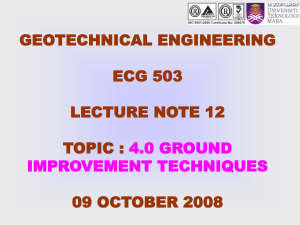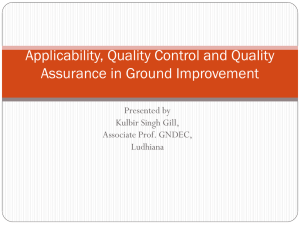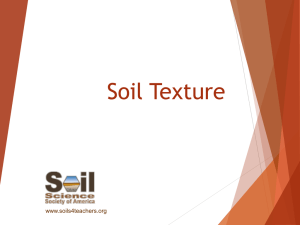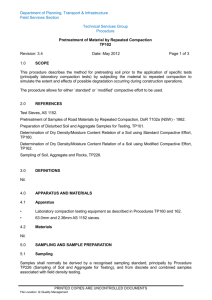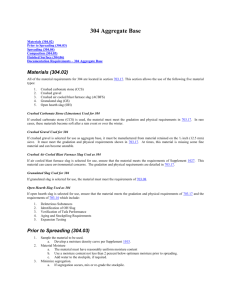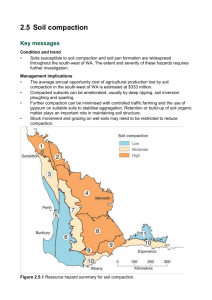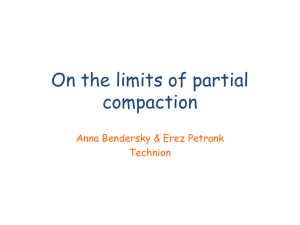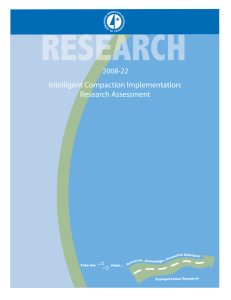ecg503 week 12 lecture note chp4
advertisement
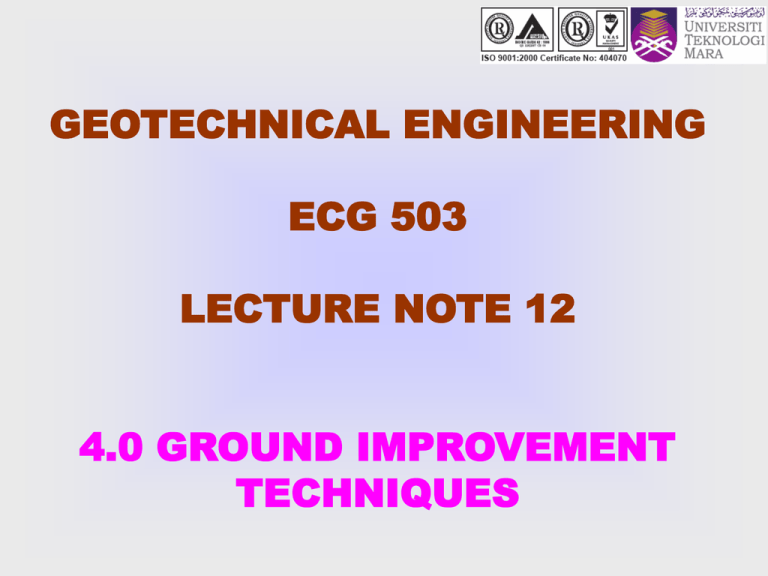
GEOTECHNICAL ENGINEERING ECG 503 LECTURE NOTE 12 4.0 GROUND IMPROVEMENT TECHNIQUES LEARNING OUTCOMES Learning outcomes: At the end of this lecture/week the students would be able to: Understand natural slope and made engineered soil slope assessment which include rainfall induced failure and role of suction. TOPIC TO BE COVERED Mechanical Methods and Objective; Stone Column, Dynamic Compaction, Vibrofloatation and Vibro Compaction. Physical and Chemical Methods and objective; Grouting and cement column Hydraulic Methods and Objective of Vertical Drain and Preloading Vibrating Plates for compacting very small areas effective for granular soils Smooth-wheeled Roller Smooth Wheeled Roller Compacts effectively only to 200-300 mm; therefore, place the soil in shallow layers (lifts) Sheepsfoot Roller to Compact Clay Soils Sheepsfoot Roller Provides kneading action; “walks out” after compaction Very effective on clays Impact Roller to Compact the Ground Impact Roller Provides deeper (2-3m) compaction. e.g., air field Dynamic Compaction - pounding the ground by a heavy weight Suitable for granular soils, land fills and karst terrain with sink holes. Pounder (Tamper) solution cavities in limestone Crater created by the impact (to be backfilled) Pounder (Tamper) Mass = 5-30 tonne Drop = 10-30 m Vibroflotation Suitable for granular soils Practiced in several forms: vibro–compaction stone columns vibro-replacement Vibroflot (vibrating unit) Length = 2 – 3 m Diameter = 0.3 – 0.5 m Mass = 2 tonnes (lowered into the ground and vibrated) Vibroflotation Vibroflotation Blasting For densifying granular soils Fireworks? Aftermath of blasting Earthmoving Equipment Large Excavator (see minivan on left for scale) Grader for spreading soil Bulldozer for spreading soil evenly Loader Backhoe Crawler mounted Hydraulic Excavator Rock Breaker Filed Compaction Different types of rollers (clockwise from right): Smooth-wheel roller Vibratory roller • Pneumatic rubber tired roller Sheepsfoot roller Big weights dropped from 25 m, compacting the ground. Craters formed in compaction GENERAL BACKGROUND OF SOFT CLAY Malaysia Coastal Area – Not fully developed Soft clay usually located around the coastal area The soft clay have been a source of difficulties for many years. The soft soil can cause settlement which can give a lot of problem and damage in several way. This is the reason why Malaysia’s coastal areas are not generally developed TWO DISTINCT ATOMIC STRUCTURAL UNITS hydroxyl or oxygen oxygen aluminium or magnesium silicon 0.26 nm Silicon Tetrahedron 0.29 nm Aluminium Octahedron Micro-fabric particles in natural clay. Flocculated Dispersed Flaky shape Plate like structure ION EXCHANGE Ground Improvements for Soft Clay • Stone Column (Vibro-Replacement) • Prefabricated Vertical Drain • Cement Column VIBRO-REPLACEMENT (STONE COLUMN) Vibro-Replacement • Also known as stone column. The technique are similar to vibroflotation/vibrocompaction except the granular fill materials which used is sand is replaced by gravel stone sizes ranging from 50mm to 100mm Soil Layer -Increase in density - Increase in bearing capacity - Radial drainage (help to improve settlement) - Shear strength of soil improve - Reinforcing the soil by applying rigid member (stone column) inside the soil Stone Columns vibrator makes a hole in the weak ground hole backfilled ..and compacted Densely compacted stone column PREFABRICATED VERTICAL DRAIN (PVD) CEMENT COLUMN (CHEMICAL STABILIZATION) APPLICATION OF STABILIZE CLAY GROUTING TECHNIQUE EXAMPLE OF CASE STUDY FOR GROUND IMPROVEMENT METHODS ON SOFT CLAY GEOTEXTILES
